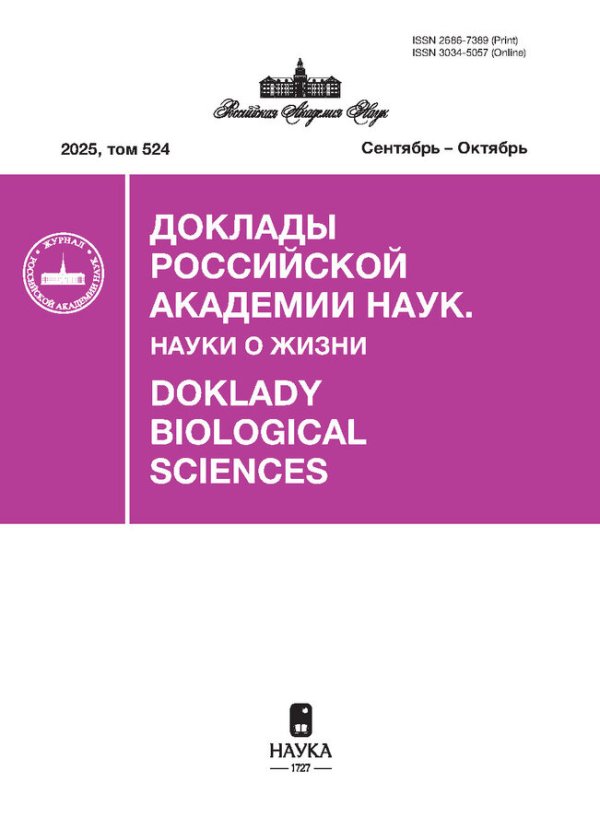Investigation of the functional role of the conserved sequence at the 5’-end of the fourth intron of the mod(mdg4) gene in trans-splicing in Drosophila melanogaster
- Authors: Soldatova Y.V.1, Beginyazova O.1, Georgiev P.G.1, Tikhonov M.V.1
-
Affiliations:
- Institute of Gene Biology Russian Academy of Sciences
- Issue: Vol 521, No 1 (2025)
- Pages: 219-224
- Section: Articles
- URL: https://medbiosci.ru/2686-7389/article/view/306239
- DOI: https://doi.org/10.31857/S2686738925020098
- ID: 306239
Cite item
Abstract
About the authors
Yu. V. Soldatova
Institute of Gene Biology Russian Academy of Sciences
Email: me@mtih.me
Moscow, Russian Federation
O. Beginyazova
Institute of Gene Biology Russian Academy of SciencesMoscow, Russian Federation
P. G. Georgiev
Institute of Gene Biology Russian Academy of SciencesMoscow, Russian Federation
M. V. Tikhonov
Institute of Gene Biology Russian Academy of SciencesMoscow, Russian Federation
References
- Wright C.J., Smith C.W.J., Jiggins C.D. Alternative splicing as a source of phenotypic diversity. // Nat Rev Genet, 2022, № 23(11): P. 697–710.
- Labrador M., Mongelard F., Plata-Rengifo P., et al. Protein encoding by both DNA strands. // Nature, 2001, № 409(6823): P. 1000.
- Horiuchi T., Giniger E., Aigaki T. Alternative trans-splicing of constant and variable exons of a Drosophila axon guidance gene, lola. // Genes Dev, 2003, № 17(20): P. 2496–501.
- Shi X., Singh S., Lin E., et al. Chimeric RNAs in cancer. // Adv Clin Chem, 2021, № 100: P. 1–35.
- Tikhonov M., Utkina M., Maksimenko O., et al. Conserved sequences in the Drosophila mod(mdg4) intron promote poly(A)-independent transcription termination and trans-splicing. // Nucleic Acids Res, 2018, № 46(20): P. 10608–10618.
- Gao J.L., Fan Y.J., Wang X.Y., et al. A conserved intronic U1 snRNP-binding sequence promotes trans-splicing in Drosophila. // Genes Dev, 2015, № 29(7): P. 760–71.
- McManus C.J., Duff M.O., Eipper-Mains J., et al. Global analysis of trans-splicing in Drosophila. // Proc Natl Acad Sci USA, 2010, № 107(29): P. 12975–9.
- Bonchuk A.N., Balagurov K.I., Baradaran R., et al. The Arthropoda-specific Tramtrack group BTB protein domains use previously unknown interface to form hexamers. // Elife, 2024, № 13.
- Melnikova L., Kostyuchenko M., Molodina V., et al. Multiple interactions are involved in a highly specific association of the Mod(mdg4)-67.2 isoform with the Su(Hw) sites in Drosophila. // Open Biol, 2017, № 7(10).
- Soldatova Iu., Shepelev M., Georgiev P., et al. A Novel Mechanism for Transcription Termination in the mod(mdg4) Locus of Drosophila melanogaster. // Biology (Basel), 2024 in press.
- Kaida D., Berg M.G., Younis I., et al. U1 snRNP protects pre-mRNAs from premature cleavage and polyadenylation. // Nature, 2010, № 468(7324): P. 664–8.
- Tikhonov M., Georgiev P., Maksimenko O. Competition within Introns: Splicing Wins over Polyadenylation via a General Mechanism. // Acta Naturae, 2013, № 5(4): P. 52–61.
- Bischof J., Maeda R.K., Hediger M., et al. An optimized transgenesis system for Drosophila using germ-line-specific phiC31 integrases. // Proc Natl Acad Sci U S A, 2007, № 104(9): P. 3312–7.
- Hernandez G., Vazquez-Pianzola P., Sierra J.M., et al. Internal ribosome entry site drives cap-independent translation of reaper and heat shock protein 70 mRNAs in Drosophila embryos. // RNA, 2004, № 10(11): P. 1783-–97.
- Zhang X., Koolhaas W.H., Schnorrer F. A versatile two-step CRISPR- and RMCE-based strategy for efficient genome engineering in Drosophila. // G3 (Bethesda), 2014, № 4(12): P. 2409–18.
- Ozturk-Colak A., Marygold S.J., Antonazzo G., et al. FlyBase: updates to the Drosophila genes and genomes database. // Genetics, 2024, № 227(1).
- Crooks G.E., Hon G., Chandonia J.M., et al. WebLogo: a sequence logo generator. // Genome Res, 2004, № 14(6): P. 1188–90.
Supplementary files










